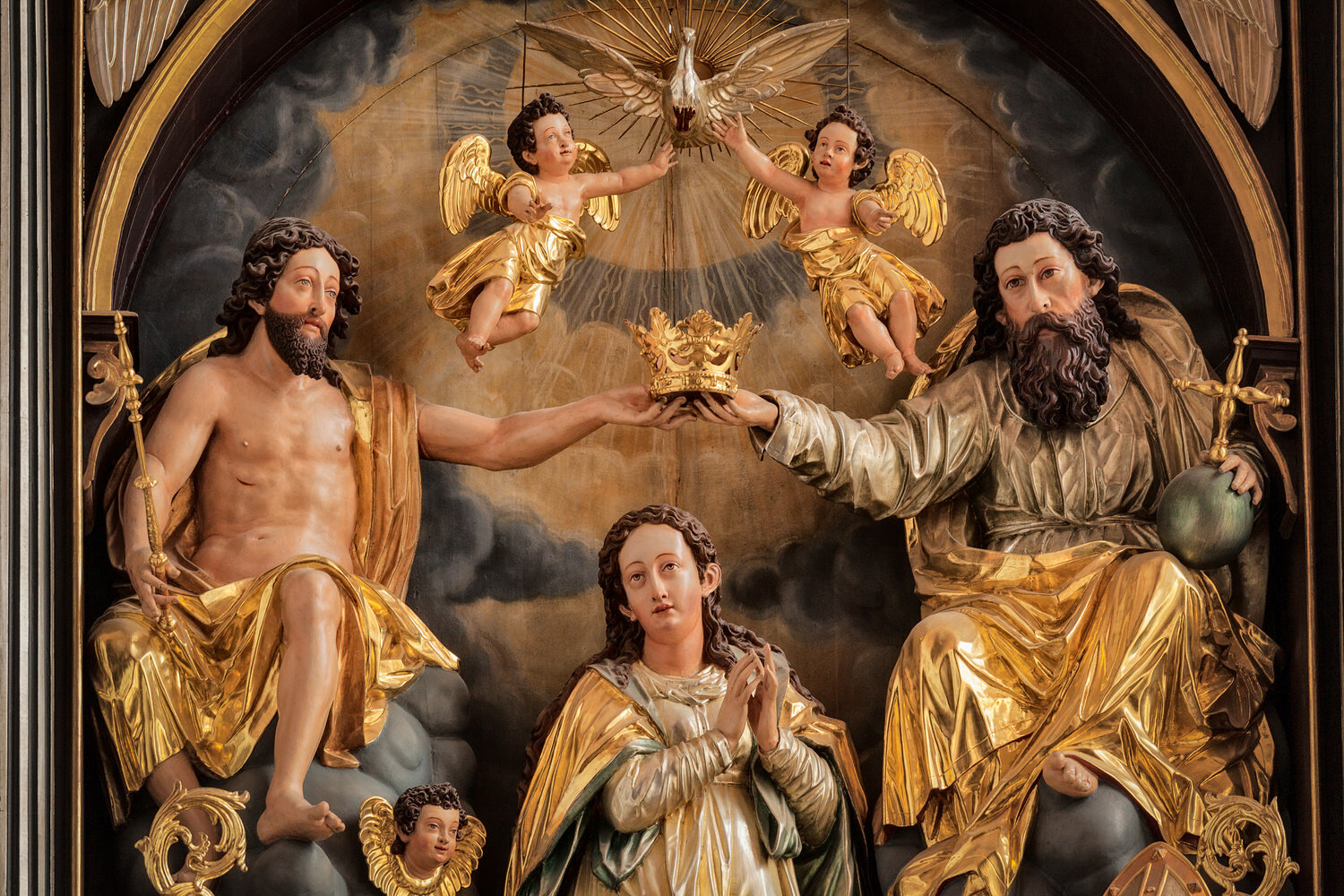Sound Of Music Church in Mondsee: The Wedding of Maria and Baron von Trapp
Expansive interior view of the Basilika St. Michael in Mondsee, Austria.
Remember the Sound Of Music and the lovely church where Maria married Baron von Trapp? During my visit and subsequent research I discovered things that watching the movie with my folks, all those years ago, couldn’t possibly have prepared me for.
The Sound Of Music church, in which the wedding scene of Maria and Baron Georg von Trapp was filmed, is the Basilika St Michael in the tourist town of Mondsee, Austria. Be prepared for the beautiful and macabre sights that await you in this lovely cloister church.
The Sound Of Music is, of course, the fabulously successful and eternally popular motion picture film staring actors Julie Andrews and Christopher Plumber.
The film is actually an adaption of the 1959 musical of the same name featuring the famous Rodgers and Hammerstein soundtrack.
Table of Contents:
Where Did Maria Actually Get Married?
Just a short drive from the regional centre, Salzburg, Mondsee is part of the Sound Of Music tourist trail.
Sign up for a half or full day tour, as I did, and you'll likely find yourself visiting Mondsee as part of the fun.
The fame of the Basilika St Michael (referred to in English as the Basilica St Michael) grew dramatically after featuring as the location for the wedding ceremony in the fabulously successful Sound Of Music motion picture film.
You may remember the famous scene from the wedding where Maria, led by Liesl, walked down the aisle at St Michaels.
Without wanting to spoil the Hollywood created illusion Maria's wedding actually took place in Nonnberg Abbey, in nearby Salzburg.
Nonetheless, as many as 200,000 people visit Basilica St Michael every year to see the place where actors Julie Andrews and Christopher Plumber took their vows as Maria and Baron Von Trapp.
How To Get To Mondsee, Austria
At an elevation of 493 meters the lovely tourist town of Mondsee is situated alongside the picturesque Lake Mondsee (i.e., Moon Lake).
Mondsee is only 15 miles (24 km) east of Salzburg. In good traffic you should be able to make the drive in around 30 minutes.
With a population of around 4,000 people Mondsee is well worth a visit, either as part of a day trip or as an excellent overnight location from which to explore the region.
The area was once part of Bavaria but, except for a short period during the Napoleonic era, Mondsee has remained a part of Austria since 1506.
Exterior view of the Basilika St. Michael in Mondsee, Austria.
Basilika St. Michael, Mondsee
Built in the late-Gothic style the 15th century Basilika St. Michael is the second largest church in Upper Austria.
A major tourist attraction the basilica continues to play an important role as the cultural and spiritual heart of the Mondsee region.
The basilica's two towers extend an impressive 52 meters in height and the building's bright, pastel color scheme welcomes tourists and parishioners to this very popular place of pilgrimage and devotion.
In 2005 Pope John Paul II upgraded the church to the status of basilica and, after a massive restoration, Basilika St. Michael reopened in 2009.
About to Travel
History Of St Michael Basilica
The history of the site on which St Michael Basilica now stands goes back over a thousand years.
Once the heart of an important monastery, itself founded on the ruins of a Roman settlement in 748 AD, the monastery played an important role in the region until it was closed around the year 1792.
Saint Wolfgang of Regensburg (Ratisbon in English) spent a year in and around Mondsee in 976.
Recognized as a saint of both the Roman Catholic and Eastern Orthodox churches, Saint Wolfgang of Regensburg is regarded as one of the three great German saints of the 10th century.
During his stay the Bishop of Regensburg also founded the beautiful Pilgrimage Church by the shores of Wolfgangsee lake.
You can reach the Pilgrimage Church by road from Mondsee. It’s only 14 miles (22 km) away.
Just be aware that, unlike Basilika St. Michael, photography is not permitted inside the Pilgrimage Church.
St. Michael's Basilica Opening Hours
St. Michaels Basilica is open daily from 9am till 7pm. Entrance to the basilica is free, though a small donation is requested for the purposes of conservation.
If you're particularly interested in the history of the basilica you might enjoy a guided tour. Just call the Mondsee parish on 0043 6232 4166 for all the details.
How to Photograph Basilika St. Michael
Basilika St. Michael is an inspiring site to behold and I had a lot of fun making photos during my visit. To make the most of my opportunities I made photos exploring the following:
Exterior images showing the height and character of the building.
Images showcasing the site’s grand and expansive interior.
Detailed images exploring the altar, tabernacle and the statues inside this glorious structure.
Should you get the opportunity to visit this or other sites of pilgrimage and devotion I recommend, where appropriate to do so, you take the same approach.
People can be included in your photos as the primary subject in a portrait or environmental portrait.
The environmental portrait allows you to depict a person in an environment to which they seem to belong.
In this case you might photograph the local abbot, organist or even a fellow tourist at St. Michaels.
Here’s a special Environmental Portrait guide I created to show you how to go about doing just that.
Alternatively, people can provide a good indication of size and scale in photos that seek to depict the site’s architectural characteristics.
As you can see that’s exactly what I did when composing the image at the very top of this post made looking back down the aisle from the altar at St. Michaels.
Either way it’s important to be aware that it can be difficult to exclude people from expansive, wide angle views at popular tourist locations like St. Michaels Basilica in Mondsee.
Often your best approach will be to incorporate visitors into your photos in a way that improves the composition. Exploring scale is one way to do so.
Even though the church was open to the public, and there were a number of tourists wondering around, I know enough about such places to respect the churches more sacred spaces.
It’s not good form to walk up onto the altar area of a church without permission.
You see the tabernacle is a fixed, locked container in which some Christian churches store the consecrated Eucharist.
It’s true that, like me, you might be able to stand back and zoom in with a telephoto lens but, either way, I’d advise that you obtain permission if it’s at all possible to do so.
Tabernacle, skeletons and relics in the Basilika St. Michael in Mondsee, Austria.
St. Michael Altar: Tabernacle, Skeletons and Relics
Take a close look at the above photo. It’s a carefully composed detail from the altar at the magnificent Basilika St. Michael.
Silver and gold are beautiful to behold and, when organized into a composition that makes sense, can become great subject matter for the photographer.
I've long approached places of worship with a sense of awe. When it comes to making photos I’m careful to act in an appropriate manner and to be respectful of the needs of tourists and devotes alike.
Regardless of the religion it's hard not to be moved by the beauty of the architecture and the sense of connection with the sublime in these places of worship.
The above image is curious in that, as well as being a close-up study of an altar in a Catholic basilica, it contains both beautiful and more macabre subject matter.
I invite you to examine the lovely tabernacle and the recessed areas on either side of it. Look closely and discover what sits behind those candle holders.
“There’s what you see initially and there’s what will only be revealed through a more critical examination of what’s in front of you.”
A closer look will reveal some unexpected elements in the shaded areas on either side of the image. Just click on the photo to see it enlarged, nice and big.
It’s a good example of the need to look more closely at the world around you. What’s more, it’s the kind of exploration that’s so brilliantly suited to the art of photography.
I've long been interested in dualities and many of my photographs seek to explore the notion of combining opposites within the same image.
Examples of such dualities include the following:
Beauty and horror
Life and death
Light and dark
Warm and cool
The altar, which appears in the original Sound Of Music motion picture film, is quite a sight.
It’s unique in that it houses relics and decorated skeletons of martyrs, including that of Abbot Konrad II. He was killed defending the monastery from noblemen, who desired to repossess the land, on which the basilica was built, in 1145.
This photo shows just part of the ornate altar which was designed as a giant reliquary. I’m sure you’ll agree that this detailed photo reveals an unexpected and quite macabre discovery.
Frankly, it wasn’t until I post processed the original photo on my computer that I began to understand what it was I was looking at.
The scene itself was quite high in contrast and it wasn’t until I began to lighten the shadows on the desktop that this mix of beauty and the macabre become evident.
The revelation that followed was immediate and prompted some study to discover what I was actually looking at.
During your own visit make sure you look up as you explore St. Michaels. There’s a series of smaller altars, featuring lovely paintings, along the walls of the basilica.
What’s more, for a small donation, you can pick up a small bottle of holy water.
Color surrounds the Cafe-Konditorei Braun in the town of Mondsee, Austria.
Conclusion: Beyond The Sound Of Music Church
There’s a lot to see at the Basilika St. Michael and, if you’re a keen photographer, you should allow an hour for yourself to properly explore and photograph the site.
While in Mondsee I'd recommend you visit one of the town's popular cafes or restaurants. There’s a line of them just a two minute walk from the basilica.
The food is good quality and the apple strudel and vanilla ice cream are quite famous. It's a reputation that, from my point of view, is well deserved.
If you have the time it’s worth taking a walk around Mondsee. It’s a pretty town with a lovely lake.
However, for most folks the magnificent Basilika St. Michael is the main attraction in Mondsee. If you’re a Sound Of Music fan, you won’t want to miss the opportunity to visit the church were Maria got married.








